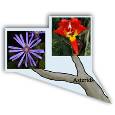Asterids
 Most Asterids show a combination of derived floral characteristics. Fused petals,
reduced numbers of stamens attached to the corolla, and zygomorphic flowers are all
commonly encountered within the Asterids. However, the only morphological synapomorphy
that all Asterids share is the presence of a single integument layer on the embryo,
which is useless as a field mark. As currently recognized, the Asterids contain some
plants formerly classified as Rosids or Dilleniids. The family Asteraceae has perhaps
the most modified inflorescences of any angiosperm; the superficial "flowers" of many
Asteraceae are actually a disk of many crowded, radially symmetric flowers, surrounded
by a ring of ligulate flowers that each resemble one petal.
Most Asterids show a combination of derived floral characteristics. Fused petals,
reduced numbers of stamens attached to the corolla, and zygomorphic flowers are all
commonly encountered within the Asterids. However, the only morphological synapomorphy
that all Asterids share is the presence of a single integument layer on the embryo,
which is useless as a field mark. As currently recognized, the Asterids contain some
plants formerly classified as Rosids or Dilleniids. The family Asteraceae has perhaps
the most modified inflorescences of any angiosperm; the superficial "flowers" of many
Asteraceae are actually a disk of many crowded, radially symmetric flowers, surrounded
by a ring of ligulate flowers that each resemble one petal.
The orders of Asterids have been subgrouped by the APG (1998) and others into groups known as Euasterid I and Euasterid II, with the orders Cornales and Ericales branching before divergence of those clades. Boraginaceae is still unplaced to order within the Asterid I clade.
More information coming soon...









